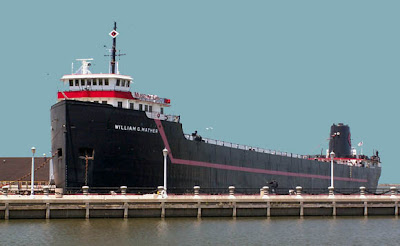
Forget Paris…well, I mean Dijon. Mustard, that is. There are only two kinds of mustard for true Clevelanders. One is Stadium Mustard, and the other is Bertman Original Ball Park Mustard. Stadium Mustard is currently the official mustard of Progressive Field, is featured at 150 stadiums and arenas throughout the United States, and has been served to astronauts on the Space Shuttle. Bertman’s had been used at Cleveland Municipal Stadium. Both mustards are a not so pleasing color of brown, and both have a distinctive spicy, tart/tangy taste.
But trying to say – or even think – that one is better than the other could start a war, or worse yet, a hockey game could break out. Bertman lovers call Stadium Mustard an “inferior counterfeit” and a “knock-off”; Stadium Mustard lovers say theirs just tastes better and the proof is that it's used in so many sports arenas. So I won’t tell you which one I like best. But I did a little research to bring out the details of who was the first stadium/ballpark mustard.
There are some details in the Encyclopedia of Cleveland History about Bertman’s:
The company was founded in 1920 by JOSEPH BERTMAN who was born in Lublin, Poland, and came to Cleveland as a child with his parents. He began the company in a garage at the Bertman home at E. 147th near Kinsman, where spices and pickles were processed and packaged. The firm relocated to 653 E. 103rd by the mid-1930s, and was then known as the Bertman Pickle Co. Soon afterward, the company relocated to 2180 E. 76th near Cedar. It is now located at 7777 Grand Avenue….Bertman's Original Ball Park Mustard is the company's best known product. Bertman himself said that the Cleveland Stadium was his first customer in 1932, but some sources indicate that the mustard was first sold at LEAGUE PARK baseball games in 1938. The spicy, tan mustard, considered by some to be the best available, is custom-blended from a secret recipe. Until the early 1970s it was only sold in gallons, but afterwards was carried by supermarkets. It was available at the Cleveland Stadium as well as the new baseball park, Jacobs Field.
David Dwoskin, President, Davis Foods Company, who makes Stadium mustard, says on Stadium Mustard’s web site:
When I was only twelve years old, my father took me to the Cleveland Municipal Stadium for the first time. I don't remember who was playing, but I do remember biting into my first hot dog with this delicious brown mustard on it. This was part of growing up in Cleveland. For more than fifty years, this mustard was served at the old Stadium, "a true Cleveland tradition". Thirty years ago I made that same mustard available in supermarkets and gave it a name - The Authentic Stadium Mustard, named after the Cleveland Stadium.”
So it appears Bertman’s is truly the ORIGINAL. But whose mustard is the best? If you want to taste test and you’re living here in Cleveland, you can easily get both. Well, maybe not so easy; I get Bertman’s at my local Heinen’s (who only carries the best stuff, by the way) but I couldn’t find a slot for Stadium mustard on the shelf…Oops, did I just tip my hand to my house favorite?
Check out my blog home page for the latest Cleveland information, here.
But trying to say – or even think – that one is better than the other could start a war, or worse yet, a hockey game could break out. Bertman lovers call Stadium Mustard an “inferior counterfeit” and a “knock-off”; Stadium Mustard lovers say theirs just tastes better and the proof is that it's used in so many sports arenas. So I won’t tell you which one I like best. But I did a little research to bring out the details of who was the first stadium/ballpark mustard.
There are some details in the Encyclopedia of Cleveland History about Bertman’s:
The company was founded in 1920 by JOSEPH BERTMAN who was born in Lublin, Poland, and came to Cleveland as a child with his parents. He began the company in a garage at the Bertman home at E. 147th near Kinsman, where spices and pickles were processed and packaged. The firm relocated to 653 E. 103rd by the mid-1930s, and was then known as the Bertman Pickle Co. Soon afterward, the company relocated to 2180 E. 76th near Cedar. It is now located at 7777 Grand Avenue….Bertman's Original Ball Park Mustard is the company's best known product. Bertman himself said that the Cleveland Stadium was his first customer in 1932, but some sources indicate that the mustard was first sold at LEAGUE PARK baseball games in 1938. The spicy, tan mustard, considered by some to be the best available, is custom-blended from a secret recipe. Until the early 1970s it was only sold in gallons, but afterwards was carried by supermarkets. It was available at the Cleveland Stadium as well as the new baseball park, Jacobs Field.
David Dwoskin, President, Davis Foods Company, who makes Stadium mustard, says on Stadium Mustard’s web site:
When I was only twelve years old, my father took me to the Cleveland Municipal Stadium for the first time. I don't remember who was playing, but I do remember biting into my first hot dog with this delicious brown mustard on it. This was part of growing up in Cleveland. For more than fifty years, this mustard was served at the old Stadium, "a true Cleveland tradition". Thirty years ago I made that same mustard available in supermarkets and gave it a name - The Authentic Stadium Mustard, named after the Cleveland Stadium.”
So it appears Bertman’s is truly the ORIGINAL. But whose mustard is the best? If you want to taste test and you’re living here in Cleveland, you can easily get both. Well, maybe not so easy; I get Bertman’s at my local Heinen’s (who only carries the best stuff, by the way) but I couldn’t find a slot for Stadium mustard on the shelf…Oops, did I just tip my hand to my house favorite?
Check out my blog home page for the latest Cleveland information, here.








